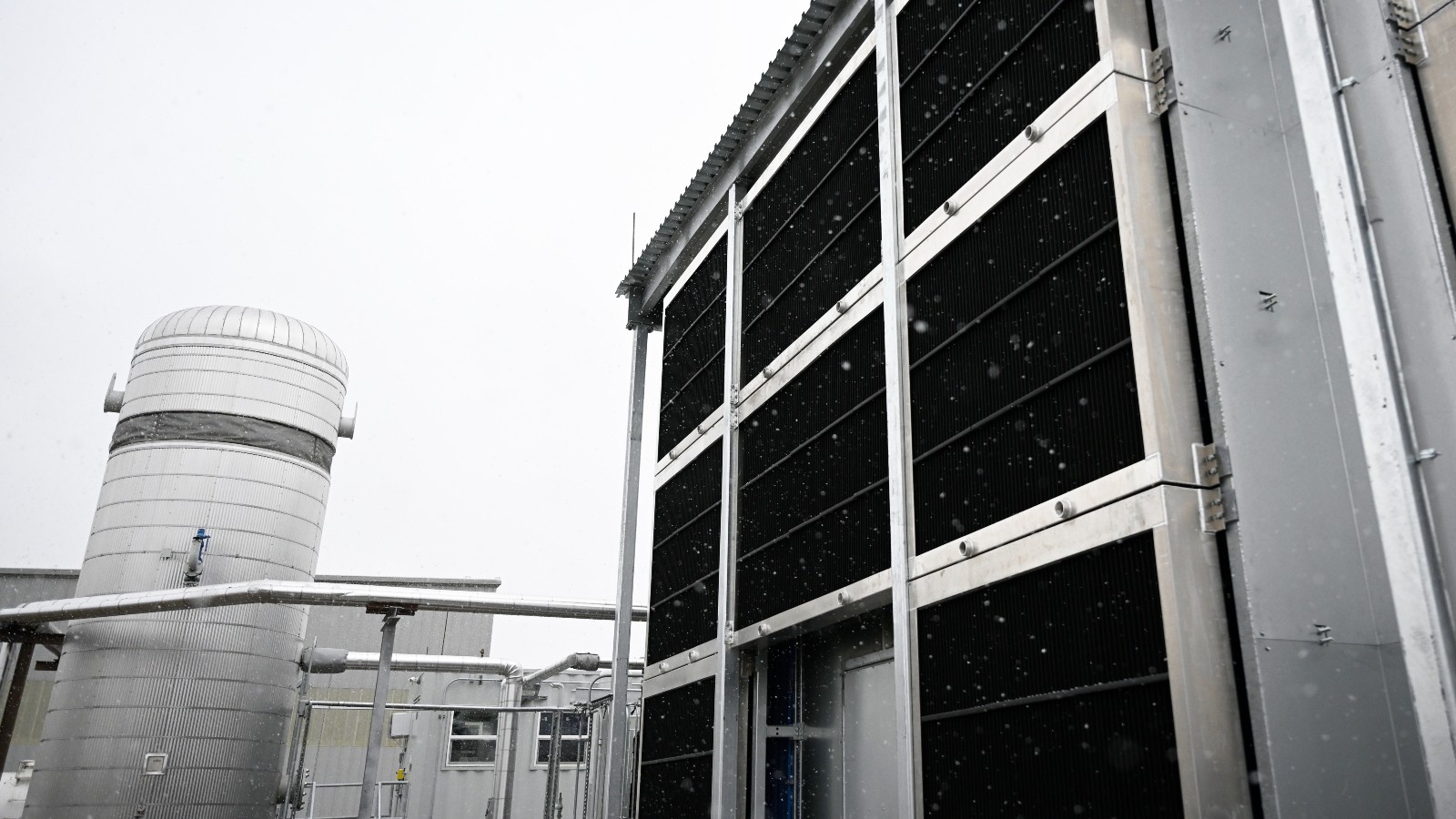This story was originally published by the Guardian and is reproduced here as part of the Climate Desk collaboration.
Rising out of the arid scrubland of western Texas is the world’s largest project yet to remove excess carbon dioxide (CO2) from the atmosphere, a quest that has been lauded as essential to help avert climate catastrophe. The creators of the project have now been awarded funding from the Biden administration, even as critics attack the technology as a fossil fuel industry-backed distraction.
Proponents of setting up enormous fans to gulp in huge amounts of air and remove planet-heating carbon from it, a process called direct air capture (DAC), are basking in their greatest breakthroughs yet in the US. In June, ceremonial shovels were plunged into the dirt in Ector County, Texas, to mark the start of a $1 billion project called Stratos, which aims to remove 500,000 tons of CO2 from the atmosphere a year once fully operational in 2025.
The advent of the 65-acre (26-hectare) site, which will be marked by a vast network of pipes, buildings and fans to scrub CO2 from the air and then inject it into underground rock formations, was solemnly likened to the Apollo 13 moon mission by Lori Guetre, vice-president of Carbon Engineering, the Canadian-founded company spearheading Stratos, during the groundbreaking.
“This time the Earth has some serious complications, and it needs the brightest minds,” Guetre said, adding that “that the world is watching and counting on us … The team’s will to overcome is quiet, steady, and unwavering.”
This milestone was followed, in August, by President Joe Biden’s Department of Energy announcing that two facilities – one a separate venture by Carbon Engineering, in the southern reaches of Texas – will be given $1.2 billion to act as DAC “hubs” to help jumpstart the carbon-removal industry in the US while also purging more than 2 million tons of CO2 from the atmosphere between them. A further two hubs will be chosen by the federal government, as part of a $3.5 billion effort to help create a market for carbon that will be “crucial to tackling climate change”, according to Jennifer Granholm, the US secretary of energy.
The commitments to remove such volumes of CO2 is a step-change for a direct air capture industry still nascent, small-scale, and unproven in its capacity to curb the worsening climate crisis, even as hope, and dollars, are ladled upon it. “It’s an extraordinarily big moment for carbon removal right now and for direct air capture in particular,” said Erin Burns, executive director of Carbon180, a climate NGO that works on a range of different carbon-removal options.
“There’s too much CO2 in the atmosphere. People are already feeling the impacts of climate change. We need to address legacy emissions and direct air capture could play a big role in that.”
But some climate campaigners have argued that DAC is, at best, a costly irrelevance to the more pressing need to cut emissions and, at worst, a cynical ploy by the fossil fuel industry to maintain its polluting status quo. The Stratos project is ultimately owned by Occidental Petroleum, an American oil company that bought Carbon Engineering for $1.1 billion last month and views carbon removal as a sort of future-proofing for its industry.
“We believe that our direct capture technology is going to be the technology that helps to preserve our industry over time,” Vicki Hollub, Occidental’s chief executive, told an industry conference in March. “This gives our industry a license to continue to operate for the 60, 70, 80 years that I think it’s going to be very much needed.”
While Occidental maintains that the CO2 captured in Texas will be stored underground and used as a sort of carbon credit system for other companies to purchase, the company also touts itself as an exemplar of what it calls “net zero oil,” whereby removed CO2 is injected into rock formations to dislodge gas and oil for further extraction.
“We are going to pay an oil company to pump crap out of the ground and then pay them to put some back in – it’s plainly obvious this isn’t a climate solution,” said Jonathan Foley, executive director of Project Drawdown, which works on responses to the climate emergency.
“It’s just so silly. If you just buried dollar bills it would make more sense. This has just given big oil decades of talking points to promote a fake solution so they don’t have to stop polluting today; it’s a huge greenwashing exercise and we are falling for it.”
Foley said the Biden administration would be justified in spending a smaller amount on helping academia research direct air capture, to help mop up stubbornly persistent emissions from sources such as concrete and steel manufacture, or aviation.
But giving oil companies public money for such ventures is “unconscionable,” he said, and reminiscent of the mostly fruitless backing of carbon capture and storage – the effort to capture emissions at source from power plants and other industrial facilities that has failed to catch on despite enjoying bipartisan support in Congress.
“When it comes to throwing funding at big industries for things that have never been demonstrated at scale, there’s suddenly a lot of money for it,” Foley said. “I’ve seen this movie many times before. This is clearly playing into the big oil playbook, and to subsidize that with public money is crazy.”
There is now a yawning gap between the amount of carbon that scientists estimate will have to be removed from the atmosphere to avoid breaching dangerous global heating thresholds and the actual amount of carbon removal currently happening, or even planned.
Human activity, primarily through burning coal, oil and gas, produces about 36 billion tons of CO2 emissions a year. Given how emissions have grown in recent years despite urgent warnings of an unfolding climate crisis, there is little chance of the rapid, massive cuts needed – by as much as half this decade – to avoid severely escalating heatwaves, floods, drought and other impacts.
This shortfall, according to the UN’s Intergovernmental Panel on Climate Change (IPCC), means almost every plausible scenario to avoid 2C of warming above pre-industrial times, and certainly 1.5C warming, which countries have agreed to, involves removing large amounts of CO2 directly from the atmosphere. Up to 10 billion tons of CO2, which is double the U.S.’s total annual emissions, may have to be removed each year by 2050 just to secure a chance of hitting these goals and get to net zero emissions.
“Carbon dioxide removal is essential to achieve net zero,” as Diána Ürge-Vorsatz, vice-chair of the IPCC working group on the matter, put it last year. The IPCC says this could be done in a number of ways, such as by reforesting large areas, given that trees are the original, and best, carbon dioxide removers, or via something called bioenergy with carbon capture and storage (also known as BECCS), which involves burning trees and other vegetation for energy and capturing the resulting emissions before they escape into the atmosphere.
But issues with these alternatives – such as the vast amount of land required and uncertainties over “lost” carbon from trees due to a growing threat of wildfires – has only added to the allure of DAC, even though it remains very much in its infancy. Today, there are only 18 facilities worldwide that remove carbon from the air and store it underground, capturing less than 10,000 tons of CO2 a year, which is as much as the carbon footprint of just a few hundred Americans.
Companies such as Climeworks, which has led the way until now with its plant in Iceland, and Carbon Engineering, which has said it could achieve 100 million tons of CO2 removal in little more than a decade from now, have remained bullish that this equation will swiftly change. Meanwhile, businesses such as Alphabet, the parent company of Google, and McKinsey have started to purchase carbon removal themselves.
To facilitate this, Carbon Engineering would need to build dozens of new facilities that push air across surfaces containing a potassium hydroxide solution that chemically binds to the CO2 molecules, separating them from the air and trapping them in the liquid solution as a carbonate salt.
This would require huge amounts of money and a vast ramp-up of technology, even to make just a modest dent in the carbon debt. The Stratos facility itself would eliminate “about 260 seconds of the world’s emissions, if they could do that annually,” said Foley, working on a calculation based around there being about 36bn tons of CO2 emissions a year. “This isn’t something that is ready for prime time.”
It’s unlikely that direct air capture alone will remove all 10 billion tons a year required by 2050, according to Burns, who added there remains “a million questions” about DAC, such as the amount of energy it will require and environmental justice concerns from communities over where and how CO2 is stored underground.
“But I think we’ve seen direct air capture can be an entry point for a lot of different people to support larger climate action,” she said. “It’s about investing in a portfolio of carbon-removal solutions. There’s a sense of the need to play catch-up on mitigation, because we’re already behind where we should be on reducing emissions.”





